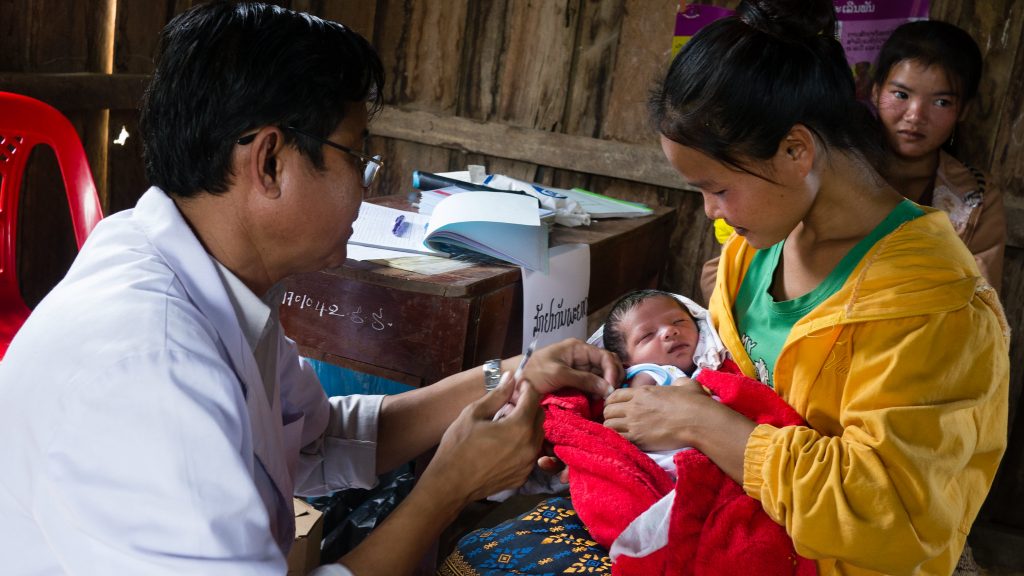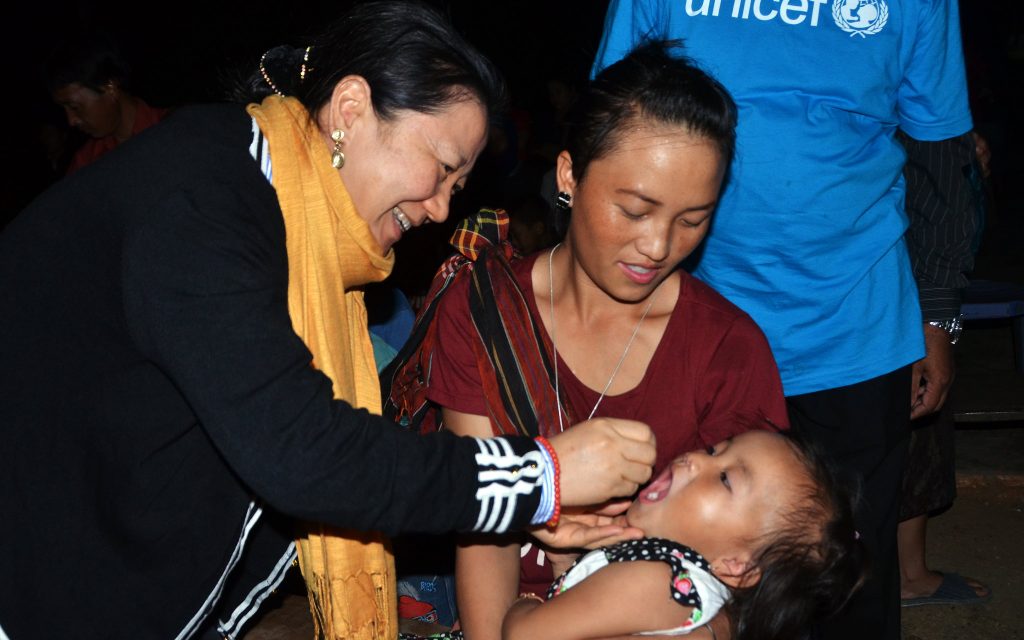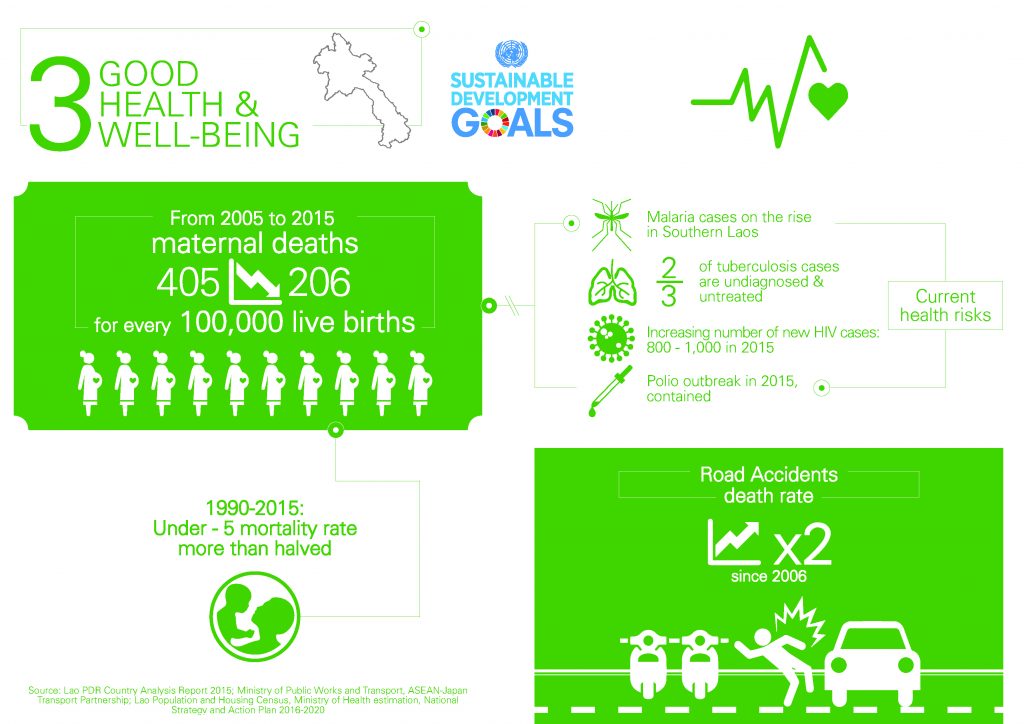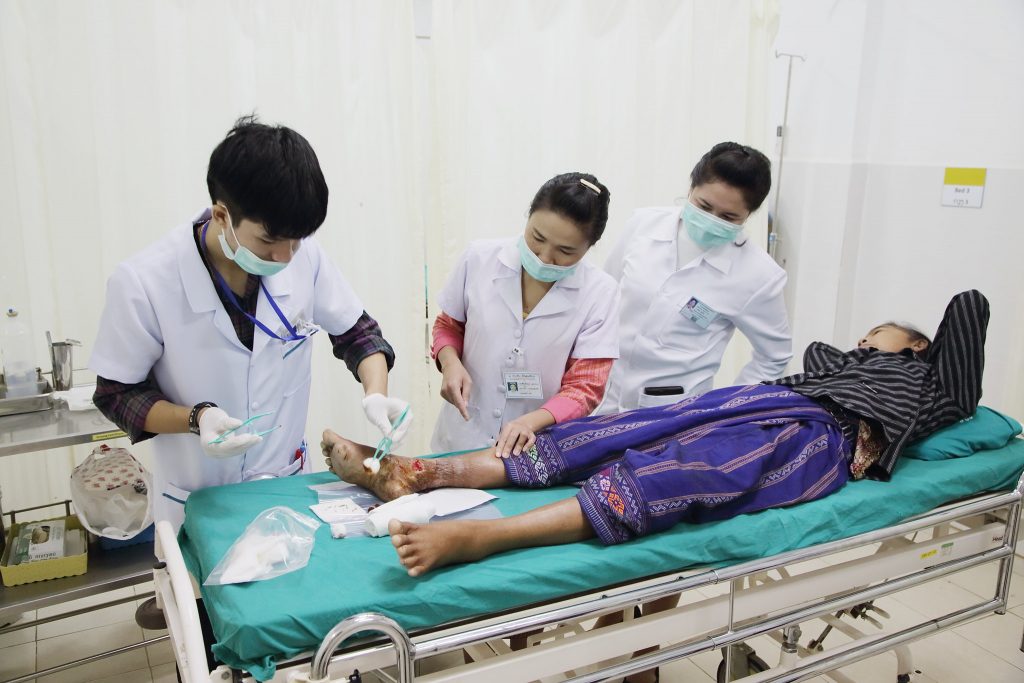Sustainable Development Goals 3 (SDG 3) – ‘Good Health and Well-being’ aims to ensure healthy lives and promote well-being for all at all ages.1 SDG 3 includes 13 targets, with 26 measuring indicators. Targets 3.1, 3.5 & 3.7 are to reduce maternal mortality and improve maternal, sexual and reproductive health, while Target 3.2 focuses neonatal, infant and under five mortality. Improving the control of HIV epidemic, tuberculosis, malaria, communicable diseases, and non-communicable diseases is in Targets 3.3 & 3.4; Targets 3.5 & 3.A are about the control of substance abuse, including alcohol, tobacco and narcotic drugs; and Targets 3.6 & 3.9 aim to reduce injuries and deaths from accident and from chemicals and environmental pollution and contamination. Targets 3.8, 3.C & 3.D are set to strengthen Health system and achieve Universal Health Coverage. Meanwhile, Target 3.B is to sustain the research and development of vaccines and medicines to ensure inclusive access and affordability.2
From the Millennium Development Goals to SDG 3
Millennium Development Goals (MDGs) are global development goals which were adopted in 2000, and set to be achieved by 2015, as a guide for development work to governments and development partners. The MDGs include 8 measurable targets, with the aim to eradicate extreme poverty and improve standards of living around the world. The MDGs focus on the development areas of education, gender equality, health, environment and global partnership for development. By the end of MDGs target implementation, Sustainable Development Goals (SDGs) have been developed to build on the successes and challenges of MDGs. By expanding the MDGs that largely focused on social development, SDGs span to all dimensions of sustainable development, economic, social and environmental. SDGs are current universal development goals that can be applied to all countries discarding their levels of development, towards to sustainable development.3

Infant Vaccination in Attepeu, Lao PDR Photo by Simon Nazer Taken on October 24, 2014 License under Simon Nazer
SDG 3 is related to MDG 4 on ‘reduce child mortality’, MDG 5 on ‘improve maternal health’, and MDG 6 on ‘combat HIV/AIDS, malaria and other diseases’. SDG 3 also includes targets on other infectious diseases, non-communicable diseases (NCDs), accidents, substance abuse and mental health, with the increased rates of deaths, illnesses and accidents in the overall mortality of developing countries.4
Regrading MDG 4, Lao PDR has achieved the national target of decreasing under-five mortality rate to 67/1,000 births in 2015, from 170/1,000 live births in 1993. Lao PDR also reached the national target of reducing infant mortality to 45/1,000 live births in 2015, from 114//1,000 live births in 1993. However, Lao PDR has failed to accomplish the international targets of reducing child mortality to one thirds of 1990 levels. Reducing child mortality is related to the proportion of immunized children. Vaccine coverage has increased steadily, even though it is still under the MDG target of 90% coverage. Measles vaccine coverage has increased to 79.5% in 2015; DPT-Hep3 coverage increased to 66.3%; and BCG coverage increased to 68.6%.5
Lao PDR has achieved the first target of MDG 5 of reducing its maternal mortality ratio (MMR) by 75%. In 2015, the MMR was estimated at 197/100,000, down from 1,660/100,000 in 1990.6 However, the MMR is still high among ASEAN counties; the MMR per 100,000 live births in Myanmar is 180, Cambodia is 161, Vietnam is 54, and Thailand is 24.6.7 Though the percentage of births assisted by skilled health personnel has increased to 53.9% in 2015, above the MDG target of 50%, high proportions of women in many provinces are still struggling with birth delivery. Laos has reached a high Antenatal care coverage with at least one visits (ANC1) of 91% in 2015, but ANC4 (ANC with at least four visits) still needs more improvement (only 52.4% in 2015).8
For MDG 6, Laos has HIV prevalence rate of 0.29% of the population in 2015, a slight increase from 0.25% in 2010, but still below the target of 0.5%. Anti-retroviral therapy (ART) is still low, with 54.8% of those who need the treatment in 2015.9
Laos has made a decent progress on tackling malaria. The incidence of malaria has decreased from 10 to 4.92 per 100,000 in 1990 and 2015 respectively. The malaria mortality rate dwindled from 9 to 0.03 per 100,000 between 1990 and 2015. Laos has also achieved the target on tuberculosis (TB). The TB incidence has decreased to 190/100,000, and the prevalence dropped to 462/100,000 in 2014. The TB treatment success rate was high (87%) in 2015.10

Polio Vaccination in Xiengkhouang province. Photo by Polio Laos Taken on December 23, 2015 License under Polio Laos
Overall, Laos has made some progress on health-related MDGs, with others to further improve. To continue the improvement of health sector and the promotion of good health and well-being in the country, Laos has localized SDG 3 to its local context, which can be classified in 8 key outcome areas: i) reduced maternal mortality and improved maternal, sexual and reproductive health (Targets 3.1 & 3.7); (ii) reduced neonatal, infant and under five mortality (Target 3.2); (iii) improved control of HIV epidemic (Target 3.3); (iv) improved control of tuberculosis, malaria, and other communicable diseases (Target 3.3); (v) improved control of NCDs (Target 3.4); (vi) improved control of substance abuse, including alcohol, tobacco and narcotic drugs (Targets 3.5 & 3.a); (vii) reduced injuries and deaths from accident (Target 3.6); and (viii) strengthened health system and achieved Universal Health Coverage (Targets 3.8, 3.c & 3.d).11
The localization of SDGs has been mainly made by incorporating into the National Socio-economic Development Plan (NSEDP), while certain targets and indicators in the NSEDP monitoring and evaluation framework have been adapted to SDGs’ to support the implementation and monitoring of both targets.12 As for SDG 3, its indicators have been integrated with the overall goal in the 8th NSEDP 2016-2020, specifically in Outcome 2, Output 4 – Universal Access to QUALITY Health Care Services. This aims mainly to expand and improve the quality of integrated public health services to ensure access to healthcare and medical services for all; strengthen public services management regularly and continuously by improving infrastructure to enable the health services to remote rural areas; increase the capacity to provide treatment and preventative medicine and apply appropriate technology in order to raise the quality of healthcare services; ensure sustainable finance for the health sector by increasing the public budget and funding to broadly cover private and community health insurance; and provide healthcare information and services, especially on reproductive health and family planning, and sanitation.13
Implementation of SDG 3 in Laos
Laos has set to achieve the Universal Health Coverage by 2025, when everyone can access quality health services without any financial restrictions. To achieve this goal, health sector reform has been introduced which focused on some priority areas such as improve capacity for health workers, improve health financing based on multi-sectoral partnerships, strengthen the governance, organization and management of the sector, enhance health service delivery and hospital management, and strengthen the health information systems.14

Source: United Nations in Lao PDR.
In line with the reform of health sector to 2025, there are several projects and programmes that support the development of health sector, for example:
Asian Development Bank (ADB) has supported A health sector governance project in the amount of US$ 15 million between 2016 and 2020. The project primarily focuses on strengthening the governance arrangements in the health sector to ensure the delivery of basic and quality health services to the majority of the population, particularly mothers and children. In addition to service delivery, the project also support the improvement of public financial management and human resources development.15
Japan International Cooperation Agency (JICA) provided around US$ 10.6 million, accordingly with in the 8th five-year National Socio-Economic Development Plan (NSEDP) and the Health Sector Reform, to support the Lao government in terms of monitoring and coordination of health sector; improving the quality of health service; and infrastructure development.16
European Union funded US$ 1.2 million for a three-year project, starting in 2014, to promote social health protection schemes in 2 districts of 2 provinces (Luang Prabang and Vientiane Province); and strengthening the financial reporting system from health facility up to the central level.17
The GAVI Alliance allocated US$ 7.5 million to Laos for health systems strengthening (HSS) over the period of 2016–2020 in 5 districts of 2 provinces. The project especially aimed to strengthen the immunization coverage by addressing constraints in the delivery of routine vaccination.18
Indicator | Year 2011/2012 | Year 2017 |
Maternal mortality ratio | 206(2015) |
|
Under-five mortality rate | 79 | 46 |
Infant mortality rate | 68 | 40 |
Neonatal mortality rate | 32 | 18 |
Full immunization coverage | 42.9 | 48.1 |
Antenatal care coverage 1 | 54.2 | 78.4 |
Antenatal care coverage 4 |
| 62.2 |
Skilled attendant at delivery | 41.5 | 64.4 |
Institutional deliveries | 37.5 | 64.5 |
Contraceptive prevalence rate | 49.8 | 54.1 |
Adolescent birth rate | 94 | 83 |
Use of basic drinking water services | 69.9 | 83.9 |
Use of safely managed drinking water services |
| 15.3 |
Handwashing facility with water and soap |
| 54.1 |
Use of basic sanitation service | 56.9 | 71.0 |
Open defecation | 37.9 | 23.9 |
The table shows progress on the implementation of SDG 3 in Lao PDR. In addition, HIV prevalence in Laos is generally low; however, HIV incidence is increasing. While HIV prevalence among female sex worker remained stable (1%), the trend of men having sex with men has increased from 1.6% to 2.4% between 2014 and 2017. The overall knowledge on HIV remains low, but HIV testing and counselling services have improved. In 2017, approximately around 75% (11,876) of the people living with HIV (PLHIV) knew their status; 47% of PLHIV were receiving antiretroviral therapy (ART), where 75% of whom had suppressed viral load.19
Laos has seen a decline in malaria cases and deaths between 2000 and 2011, but from 2011 to 2014 there is a sharp increase in the cases and deaths, mainly because of the high demand for economic activities and large development projects near or in forested areas, and porous borders.20 However, there was a declining trend of confirmed cases towards 2017 and the treatment also tends to be relatively successful.21 22 Though, bed net coverage still needs to improve; the rate of children under 5 sleeping under insecticidal nets stood at 74.3% in 2016.
Tuberculosis (TB) incidence has declined over the past decade and TB treatment success rate is also high (87% in the first half of 2018), but the TB detection rate was estimated at only 50% in 2017.23
Non-communicable diseases (NCDs) and injuries is a growing threat for Laos. In 2016, some 59.6% of total deaths were due to non-communicable diseases (NCD) in 2016. Coronary heart disease is responsible for 13.5% of all deaths in 2017. Injuries, mainly from road accidents accounts for 9% of all deaths. Deaths from road accidents is on a rise, from 15.3 per 100,000 in 2015 to 16.2 per 100,000 in 2017.24
Out-of-pocket spending is still a key challenge towards the universal health coverage, though it has decreased from 48.6% of total current health expenditures in 2010-11 to 45.1% in 2015-16. The country is highly dependent on the Global Fund and Gavi – the Vaccine Alliance – for the financing of its immunization, malaria, tuberculosis (TB), and HIV/AIDS program. However, the general government health expenditure as a percentage of general government expenditure has nearly doubled from 3.7% (2010-11) to 6.9% (2017); but it still requires to improve.25 26

An Emergency Room at the Provincial Hospital of Luang Prabang. Photo by ILO in Asia and the Pacific Taken on October 29, 2013. License under CC BY-NC-ND 2.0
Monitoring of SDG 3 Targets in Laos
Most SDG 3 Targets (3.1, 3.2, 3.3, 3.5.2, 3.7, 3.9, 3.A, 3.B and 3.C) can be monitored based on previous MDGs indicators, by using the existing health information system and Lao Social Indicator Survey (LSIS), though some still needs to be reviewed and improved for consistency. Meanwhile, Targets 3.4, 3.5.1, 3.8 and 3.D are required to be identified and incorporated to the existing systems for reports and evaluation.27
To strengthen the monitoring and reviewing of SDGs implementation, Lao PDR had developed its first National Voluntary Report (VNR) in 2018, in consultation with ministries, Government agencies and local authorities, as well as development partners, civil society organisations and private sector. The report was presented at the high level political forum (HLPF) 2018, highlighting the success, challenge and future strategies towards the goals and the 2030 Agenda for Sustainable Development.28
In addition to the VNR, Lao PDR also conducted a mid-term review of the implementation of the 8th NSEDP (localized SDGs) in the Roundtable Meeting 2018 , which focused on reviewing key outcomes of NSEDP (sustained inclusive economic growth; social and human development; and environment and disaster preparedness) along with other cross-cutting issues on legal framework and enforcement.29 30
References
- 1. United Nations. “Goal 3: Good Health and Well-being.” Accessed May 2019.
- 2. United Nations. “Sustainable Development Goal 3.” Accessed May 2019.
- 3. UN in the Lao PDR. 2017. “From Millennium Development Goals to Sustainable Development Goals: Laying the base for 2030.” Accessed May 2019.
- 4. United Nations in Lao PDR. 2016. “Discussion Paper: The Sustainable Development Goals in the context of the Lao People’s Democratic Republic.” Accessed May 2019.
- 5. Ministry of Health. 2015. “MDG Progress Report 2015: Progress and transition of Health-related MDGs to SDGs in Lao PDR.” Accessed May 2019.
- 6. Ibid.
- 7. The ASEAN Secretariat. 2018. “ASEAN Statistical Yearbook 2018.” p.18. Accessed May 2019.
- 8. Ministry of Health. 2015. “MDG Progress Report 2015: Progress and transition of Health-related MDGs to SDGs in Lao PDR.” Accessed May 2019.
- 9. Ibid.
- 10. United Nations in Lao PDR. 2013. “MDG Progress in Lao PDR.” Accessed May 2019.
- 11. The United Nations in Lao PDR. 2015. “Discussion Paper: The Sustainable Development Goals in the context of the Lao People’s Democratic Republic.” Accessed May 2019.
- 12. The United Nations in Lao PDR. 2017. “Tracking progress towards National Development Goals and Sustainable Development Goals.” Accessed October 2018.
- 13. Ministry of Planning and Investment. 2016. “8th Five-Year National Socio-Economic Development Plan (2016-2020).” Accessed May 2019.
- 14. Ministry of Health. 2016. “Health Sector Reform Strategy and Framework till 2025.” Accessed May 2019.
- 15. WHO in Lao PDR. 2015. “Universal health coverage [Lao PDR].” Accessed May 2019.
- 16. Ibid.
- 17. Ibid.
- 18. Ibid.
- 19. Ministry of Planning and Investment. 2018. “THIRD DRAFT for review MID-TERM REVIEW OF THE EIGHTH NATIONAL SOCIOECONOMIC DEVELOPMENT PLAN, 2016—2020.” Accessed May 2019.
- 20. Government of the Lao PDR. 2018. “Lao PDR Voluntary National Review on the Implementation of the 2030 Agenda for Sustainable Development.” Accessed May 2019.
- 21. World Health Organization. 2018. “Lao PDR: Malaria Profile 2018.” Accessed May 2019.
- 22. World Health Organization. 2018. “World malaria report 2018.” Accessed May 2019.
- 23. Ministry of Planning and Investment. 2018. “THIRD DRAFT for review MID-TERM REVIEW OF THE EIGHTH NATIONAL SOCIOECONOMIC DEVELOPMENT PLAN, 2016—2020.” Accessed May 2019.
- 24. Ibid.
- 25. Ibid.
- 26. Government of the Lao PDR. 2018. “Lao PDR Voluntary National Review on the Implementation of the 2030 Agenda for Sustainable Development.” Accessed May 2019.
- 27. The United Nations in Lao PDR. 2017. “Tracking progress towards National Development Goals and Sustainable Development Goals.” Accessed May 2019.
- 28. Government of the Lao PDR. 2018. “Lao PDR Voluntary National Review on the Implementation of the 2030 Agenda for Sustainable Development.” Accessed May 2019.
- 29. UNDP in Lao PDR. 2018. “Round Table Meeting 2018: Mid-term Review of the 8th NSEDP and results of the PDNA as main points of discussion.” Accessed May 2019.
- 30. Ministry of Planning and Investment. 2018. “THIRD DRAFT for review MID-TERM REVIEW OF THE EIGHTH NATIONAL SOCIOECONOMIC DEVELOPMENT PLAN, 2016—2020.” Accessed May 2019.

